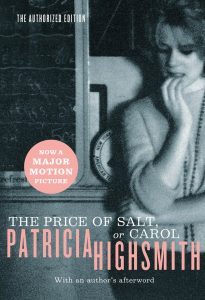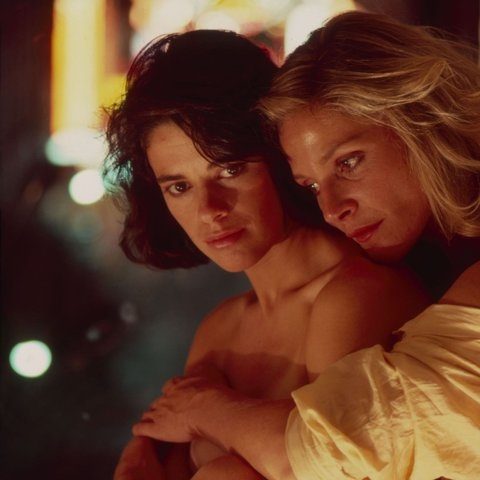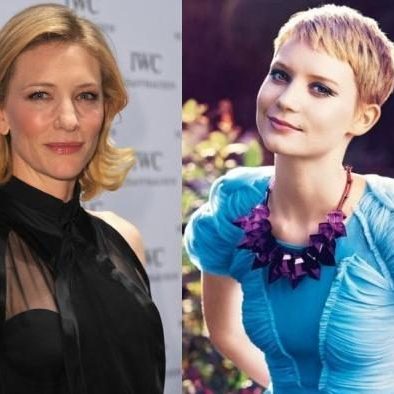 This lesbian has not seen Todd Hayne’s new film Carol and she’s still feeling a little tortured about it.
This lesbian has not seen Todd Hayne’s new film Carol and she’s still feeling a little tortured about it.
I’m ashamed to admit that after months of fevered anticipation- early reviews, festival circuit news, and most recently the film’s early release in New York and L.A.- it only occurred to me LAST WEEK that I could read Patricia Highsmith’s novel The Price of Salt (popularly known now as Carol ) to satisfy my desperate thirst for this (temporarily) unseeable film.
What kind of lesbian am I that I wasn’t familiar with this cult classic? Like I said, shameful. When I did finally lay my paws on it after a rushed Amazon Prime order, I happily settled in for what became a truly enjoyable, thirst quencher. It lasted all of one day, but for that one single day, I didn’t think about Todd Haynes and his ridiculously talented cast once.
So much has been written about this beautiful novel, and subsequent film, you hardly need me to break down all of the ways in which it’s remarkable. Namely, it’s simplicity, yet somehow plunging depth. And perhaps most notably, the fact that it is first and foremost a love story that reaches far beyond its 1940s/early 1950s inception.
Progressive without being overtly political. Political by virtue of not trying to be at all. In a perfect way, exemplifying the power and protest in simply being, without a lot of fanfare or declaration.
Throughout the novel’s twists and turns, the women of Carol continuously choose their love, choose each other, and most importantly choose being true to themselves without ever seeming to entirely trip on the societal lines drawn between what is right and wrong, acceptable and unacceptable, or moral and immoral.
The ease with which Highsmith’s women consider their affection for one another suggests that there isn’t much to chew teeth on, painting the objections of others as more of a nuisance than catastrophe. When they do stumble and doubt whether they can go on as they are, the moment is given breath, then passes as if it’s an absurd thing to even consider.
Even at the crux of Carol’s fight for the right to see her daughter, one gets the sense that her willingness to deny her love for Therese in order to win that fight is a shallow one at best.
Because, as the entirety of the story suggests, how could love ever be wrong?
While devouring Highsmith’s novel it struck me just how powerful it is to not experience what one might call an identity crisis in the face of adversity or opposition. To not have a crisis of conscience when one finds herself out on a minority limb is a blessing to be sure, and a kind of activism I find extremely appealing.
The fortitude to embrace who one is without apology or explanation, and simply live in the wholly natural state of oneself feels to me like one ultimate “way” to participate in the long fought fight for equality and justice for our queer community. And to what ultimate end? That we may be so visible that there is nothing to come out of. No closets, just wide open spaces.
I realise that, much like a fictional love story, there is a kind of idealism I’m suggesting here that may not resonate with our very real-world circumstances of grave inequality and injustice. Many of us in the LGBTQ community live within the confines of great oppression, and the very act of coming out is still the most powerful action one can contribute to the fight.
Working towards total visibility and unapologetic presence in all corners of society is the job at hand and ultimate goal.
And, something about the ease with which Highsmith tells her tale makes me dream of a closet-less utopia, when the phrase coming out isn’t synonymous with the LGBTQ experience. Like actress Holland Taylor recently declared “I haven’t come out because I am out. I live out.”
There is no talk of coming out in Carol, likely because the concept of a public declaration of one’s homosexuality wasn’t a safe move, and had been barely born in the early 1950s. As noted by Margaret Talbot in her New Yorker article Forbidden Love, Haynes was quoted saying “the indecipherability” of lesbianism at the time—the “unimagined notions of what love between women might even look like”—is the engine of Highsmith’s plot.” And, as Talbot reminds us, “…the era offered some surprising freedoms. “The Price of Salt” depicts a world where a suburban matron could take a salesgirl she’s just met out for Old-Fashioneds in the middle of the day—and where two women in love might live together, hiding in plain sight…” In a way, to be out as we know it now was such a foreign concept that the proverbial closet was hardly visible, let alone open, let alone emptied, shut, and left behind.
There is such an absence of identity politics or self-analysis in Carol that I jumped when, after noticing her new haircut and clothes, Carol says to Therese, “You know, you look very fine. You’ve come out all of a sudden.” Here, near the end of the novel on page 275 coming out makes an appearance. And, although Highsmith may be alluding under the radar to something more specifically queer, I think she’s talking about simply coming into one’s own. Queer or not, HIghsmith tells us that there is nothing more beautiful than a woman having utterly arrived to her full, unmitigated self. And if anything, that is what The Price of Salt is ultimately about; trueness, love, and coming in to oneself as a way of coming out in the world.




